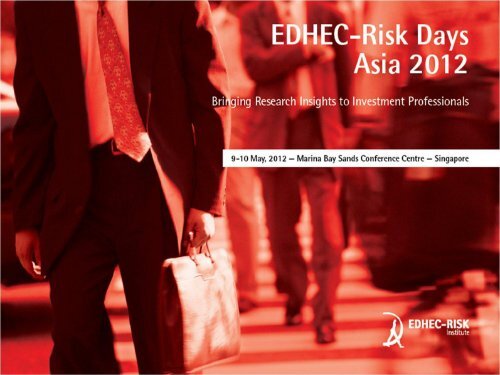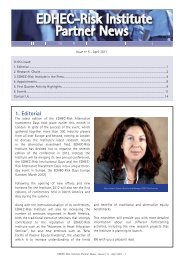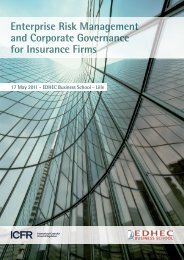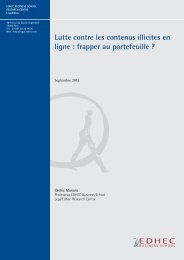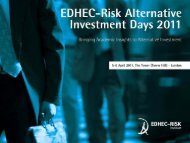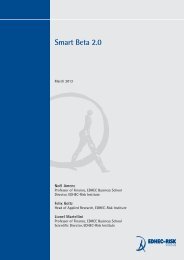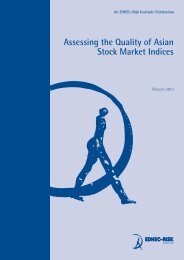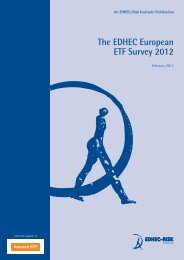EVI-Emerging Asia - EDHEC-Risk
EVI-Emerging Asia - EDHEC-Risk
EVI-Emerging Asia - EDHEC-Risk
You also want an ePaper? Increase the reach of your titles
YUMPU automatically turns print PDFs into web optimized ePapers that Google loves.
<strong>EDHEC</strong>-<strong>Risk</strong> Days Europe 2012<br />
May 10, 12:15-13:15
<strong>EDHEC</strong>-<strong>Risk</strong> Days Europe 2012<br />
May 10, 12:15-13:15<br />
A New Class of Volatility Indices<br />
for <strong>Asia</strong><br />
Stoyan Stoyanov<br />
Professor of Finance, <strong>EDHEC</strong> Business School<br />
Head of Research, <strong>EDHEC</strong>-<strong>Risk</strong> Institute–<strong>Asia</strong><br />
stoyan.stoyanov@edhec-risk.com<br />
www.edhec-risk.com
Outline<br />
• Volatility Indicators<br />
– Background and Landscape of <strong>Asia</strong>n volatility indices<br />
– Limits of Option Implied Volatility Indices<br />
• Introducing a New Form of pan-<strong>Asia</strong>n Volatility<br />
Indices<br />
– Interpretations of Cross-Sectional Volatility<br />
– The Calculation Methodology in a Nutshell<br />
• Properties of pan-<strong>Asia</strong>n CSV and a Comparison to<br />
<strong>Asia</strong>n Option-Implied Indicators.<br />
• Conclusions
• Volatility Indicators<br />
– Background and Landscape of <strong>Asia</strong>n volatility indices<br />
– Limits of Option Implied Volatility Indices<br />
• Introducing a New Form of pan-<strong>Asia</strong>n Volatility<br />
Indices<br />
– Interpretations of Cross-Sectional Volatility<br />
– The Calculation Methodology in a Nutshell<br />
• Properties of pan-<strong>Asia</strong>n CSV and a Comparison to<br />
<strong>Asia</strong>n Option-Implied Indicators.<br />
• Conclusions
Introduction<br />
• Information about volatility is very useful for<br />
investment management for both asset pricing and<br />
portfolio selection.<br />
• There has been an increased interest in volatility as<br />
an asset class – the main motivation is equity risk<br />
diversification through a long volatility exposure<br />
since changes in volatility are negatively correlated<br />
with stock index returns<br />
• Negative correlation is particularly pronounced in<br />
stock market downturns which offers much needed<br />
protection in times when other forms of<br />
diversification may be ineffective.
Explanation for Negative<br />
Correlation<br />
• Explanations for the negative correlation include:<br />
– The leverage effect – a decrease (increase) in equity<br />
prices increases (decreases) the company leverage<br />
and increases (decreases) the risk to equity holders<br />
(e.g. Black (1976)).<br />
– The volatility feedback effect – the argument is exante:<br />
an expected increase in risk of equity increases<br />
the required rate of return of future cash-flows and<br />
hence stock prices are expected to fall (e.g. French et<br />
al (1987)).<br />
• The presence of economic reasons provides<br />
confidence that the expected diversification<br />
benefits would be persistent.
Volatility Indices<br />
• Since information about volatility is important,<br />
estimation of volatility has been a topic of<br />
intensive research.<br />
• Approaches include<br />
– Backward-looking method<br />
– Cross-sectional method<br />
– Forward-looking method<br />
• The most popular index is the VIX computed<br />
from S&P500 option prices, which belongs to the<br />
forward-looking methods.
Volatility Indices in <strong>Asia</strong><br />
Index Introduced Data since<br />
S&P/ASX 200 (VIX) 2010 Jan-2008<br />
Nikkei Volatility<br />
Index<br />
(VNKY)<br />
India NSE VIX<br />
(INVIXN)<br />
KOSPI 200<br />
Volatility Index<br />
(VKOSPI)<br />
Hang Seng<br />
Volatility Index<br />
(VHSI)<br />
2010 11-Jun-1989<br />
2008 02-Nov-2007<br />
Derivatives (Futures,<br />
Options)<br />
Consultations done in<br />
2011<br />
Futures launched on<br />
27-Feb-2012. Since<br />
Apr-12 can be traded<br />
from US.<br />
Press release in 2010:<br />
NSE seeks approval<br />
from the regulator.<br />
2009 03-Jan-2003 Not available<br />
2011 02-Jan-2001<br />
Futures launched on<br />
20-Feb-2012.
Problems with Option-Implied<br />
Volatility Indices<br />
• Not available for an extensive set of markets<br />
because they require existence of a liquid option<br />
market.<br />
– Volatility indices exist for some developed <strong>Asia</strong>n<br />
markets<br />
• In developed markets, they only exist at the<br />
aggregate country large cap-stock level: no<br />
volatility index for small caps, growth/value<br />
stocks or sectors.<br />
• When they exist, option-implied volatility indices<br />
may be plagued by option-market problems that<br />
have little to do with the underlying equity<br />
market.
• Volatility Indicators<br />
– Background and Landscape of <strong>Asia</strong>n volatility indices<br />
– Limits of Option Implied Volatility Indices<br />
• Introducing a New Form of pan-<strong>Asia</strong>n Volatility<br />
Indices<br />
– Interpretations of Cross-Sectional Volatility<br />
– The Calculation Methodology in a Nutshell<br />
• Properties of pan-<strong>Asia</strong>n CSV and a Comparison to<br />
<strong>Asia</strong>n Option-Implied Indicators.<br />
• Conclusions
Introducing a New Volatility Index<br />
Series<br />
• We conceived a project on a volatility indicator<br />
which would be:<br />
– Model-free<br />
– Based on equity market data alone<br />
– Available for all markets/sectors<br />
– Available at all frequencies<br />
• We have identified a methodology and studied its<br />
properties<br />
– Garcia, R., D. Mantilla-Garcia, and L. Martellini (2011)<br />
Idiosyncratic <strong>Risk</strong> and the Cross-Section of Stock Returns,<br />
<strong>EDHEC</strong> Working Paper<br />
– Goltz, F., R. Guobuzaite, L. Martellini, S. Stoyanov (2012)<br />
Introducing a new form of volatility index: The crosssectional<br />
volatility index, Bankers, Markets, Investors No.<br />
117, March-April, pp. 19-27.
The Cross-sectional Distribution of<br />
Stock Returns<br />
• Important insight: we exploit the information<br />
content of the cross-sectional distribution of<br />
stock returns, i.e. the dispersion of stock returns<br />
at a given date, to design a novel form of a<br />
volatility indicator.<br />
• The performance of an index on a given date is a<br />
weighted average of the performance of the<br />
constituents.<br />
• Example: If an index goes down by 5%, is it the<br />
case that<br />
– All stocks went down by 5% (zero dispersion)<br />
– Half went down by 20% and half went up by 10%
1 Day Before Fukushima<br />
• The cross-sectional distribution of 450 Japanese<br />
large-cap stocks
1 Day After Fukushima<br />
All stock returns were in<br />
this range on 10-Mar-2011<br />
• The cross-sectional distribution of 450 Japanese<br />
large-cap stocks
Cross-Sectional Volatility<br />
• We propose to use the cross-sectional dispersion<br />
of returns at any given date and frequency as an<br />
observable, model-free proxy for volatility.<br />
• Formally, define for a given universe of N stocks<br />
the return on a weighting scheme w it ,<br />
• The CSV Index is then equal to
Annualized volatility<br />
CSV around the Fukushima Disaster<br />
0.8<br />
0.7<br />
0.6<br />
14-Mar-2011<br />
0.5<br />
0.4<br />
0.3<br />
0.2<br />
0.1<br />
0<br />
10-Mar-2011<br />
• Cross-sectional volatility of 450 large-cap Japanese<br />
stocks from 01-Feb-2011 to 01-May-2011.<br />
• CSV time series have information content.
• Volatility Indicators<br />
– Background and Landscape of <strong>Asia</strong>n volatility indices<br />
– Limits of Option Implied Volatility Indices<br />
• Introducing a New Form of pan-<strong>Asia</strong>n Volatility<br />
Indices<br />
– Interpretations of Cross-Sectional Volatility<br />
– The Calculation Methodology in a Nutshell<br />
• Properties of pan-<strong>Asia</strong>n CSV and a Comparison to<br />
<strong>Asia</strong>n Option-Implied Indicators.<br />
• Conclusions
Interpretations of CSV<br />
• If we assume that a single factor model holds for<br />
stock returns,<br />
• We also make the assumptions (to be relaxed<br />
later) that<br />
– All betas are the same, it = t for all i<br />
– The residual variances are the same,<br />
• Then we can show that for any regular weighting<br />
scheme,
Interpretations of CSV<br />
• Among all possible weighting schemes, the<br />
equally weighted one has a special place.<br />
• The equally weighted CSV has the smallest<br />
variance and the small sample bias can be easily<br />
calculated.<br />
• If we relax the homogeneous residual variance<br />
assumption, we obtain that the cross-sectional<br />
variance converges to a weighted average of the<br />
residual variances,
Interpretations of CSV<br />
• If we relax the homogeneous beta assumption,<br />
we obtain a biased weighted average<br />
where<br />
is a measure of dispersion of the different betas.<br />
• The bias coming from the factor turns out to be<br />
empirically negligible (Garcia et al (2011)).
• Volatility Indicators<br />
– Background and Landscape of <strong>Asia</strong>n volatility indices<br />
– Limits of Option Implied Volatility Indices<br />
• Introducing a New Form of pan-<strong>Asia</strong>n Volatility<br />
Indices<br />
– Interpretations of Cross-Sectional Volatility<br />
– The Calculation Methodology in a Nutshell<br />
• Properties of pan-<strong>Asia</strong>n CSV and a Comparison to<br />
<strong>Asia</strong>n Option-Implied Indicators.<br />
• Conclusions
Methodology in a Nutshell<br />
• The methodology for the new volatility indicator<br />
is centred on CSV with a few important<br />
additional enhancements:<br />
– Liquidity: this is an issue in emerging markets and we<br />
apply filters to reduce the noise from illiquid stocks.<br />
– Robustness: the weighting scheme is selected with a<br />
focus on robustness.<br />
– Aggregation: instead of directly working with the<br />
cross-section on regional level, we do so on a country<br />
level and then aggregate to regional level.
Methodology: Liquidity<br />
• Lack of liquidity materializes in two ways:<br />
a) The stock is not traded and we get a return of zero<br />
b) There are abnormal returns (positive or negative)<br />
• The general recommendation from academic<br />
literature with respect to a) is to remove the<br />
stocks with a zero return from the sample.<br />
• A way to deal with b) is to set a reasonable upper<br />
and lower bound on returns in the cross section.<br />
• We also set a convention rule which is especially<br />
useful for regional universes: if 50% of the<br />
returns are zeros, the index is not computed.
Methodology: Robustness<br />
• We employ techniques from robust statistics to<br />
reduce noise and increase resistance to outliers.<br />
The assumption is that cross-sectional data is<br />
contaminated.<br />
• Using equal weights w it = 1/N in the estimator or<br />
e.g. cap-weights, results in a lot of noise.<br />
• We adjust the weights to the sample so that the<br />
outliers get smaller weights (w it = 0 for severe<br />
outliers) and the returns from the center of the<br />
distribution get equal weights.
Value-Added of Robustness<br />
1.4<br />
1.2<br />
1<br />
0.8<br />
0.6<br />
0.4<br />
0.2<br />
0<br />
<strong>Emerging</strong> <strong>Asia</strong>: Equally-weighted vs Robust<br />
EW CSV<br />
Robust<br />
1.4<br />
1.2<br />
1<br />
0.8<br />
0.6<br />
0.4<br />
0.2<br />
0<br />
<strong>Emerging</strong> <strong>Asia</strong>: Cap-weighted vs Robust<br />
CW CSV<br />
Robust
Methodology: Aggregation<br />
• To reduce the bias coming from country-specific<br />
factors, for regional universes we employ a twostep<br />
procedure:<br />
– Calculate the CSV Index for all countries in the<br />
universe on a stand-alone basis.<br />
– Aggregate the cross-sectional variances by applying<br />
weights proportional to the number of stocks of each<br />
country in the regional universe.
Introducing <strong>EVI</strong><br />
• The methodology has been implemented for a<br />
universe of 12 country and regional indices and 2<br />
broad global universes.<br />
• The <strong>EDHEC</strong>-<strong>Risk</strong> Equity Volatility Indices (<strong>EVI</strong>)<br />
include the following universes:<br />
– Country level: US, Canada, UK, Japan<br />
– Regional level: Latin America, Eurozone, Dev Europe<br />
ex EUR ex UK, <strong>Emerging</strong> Europe, <strong>Emerging</strong> MEA,<br />
Developed MEA, <strong>Emerging</strong> <strong>Asia</strong>, Developed <strong>Asia</strong> ex<br />
Japan.<br />
– Global universes: World Developed, World <strong>Emerging</strong>.
Pan-<strong>Asia</strong>n Volatility Indicators<br />
• The <strong>EVI</strong>s contain three <strong>Asia</strong>n volatility indicators.<br />
• Japan: on average based on 440 stocks (in 2002-<br />
2012)<br />
• <strong>Emerging</strong> <strong>Asia</strong> includes the following countries:<br />
China, India, Indonesia, Malaysia, Pakistan, the<br />
Philippines, Thailand and Taiwan: on average<br />
based on 304 stocks (in 2002-2012)<br />
• Developed <strong>Asia</strong> ex Japan includes: Australia,<br />
Hong Kong, Korea, New Zealand, and Singapore:<br />
on average based on 496 stocks (in 2002-2012)
• Volatility Indicators<br />
– Background and Landscape of <strong>Asia</strong>n volatility indices<br />
– Limits of Option Implied Volatility Indices<br />
• Introducing a New Form of pan-<strong>Asia</strong>n Volatility<br />
Indices<br />
– Interpretations of Cross-Sectional Volatility<br />
– The Calculation Methodology in a Nutshell<br />
• Properties of pan-<strong>Asia</strong>n CSV and a Comparison to<br />
<strong>Asia</strong>n Option-Implied Indicators.<br />
• Conclusions
Properties of CSV<br />
• Although representing two different measures of<br />
uncertainty, systematic and average specific<br />
volatility indicators are expected to be highly<br />
correlated.<br />
• The rationale is that they both reflect the<br />
aggregate uncertainty by investors at a given<br />
point in time regarding economic fundamentals.<br />
• We confirm this intuition but also discover<br />
different correlations to different systematic<br />
<strong>Asia</strong>n volatility indicators.
Pan-<strong>Asia</strong>n Volatility Indicators<br />
1<br />
0.9<br />
0.8<br />
0.7<br />
0.6<br />
0.5<br />
0.4<br />
0.3<br />
0.2<br />
0.1<br />
0<br />
Japan<br />
1<br />
0.9<br />
0.8<br />
0.7<br />
0.6<br />
0.5<br />
0.4<br />
0.3<br />
0.2<br />
0.1<br />
0<br />
<strong>Emerging</strong> <strong>Asia</strong><br />
1.1<br />
0.9<br />
0.7<br />
0.5<br />
Dev <strong>Asia</strong> ex Japan<br />
The latest recession, from<br />
Dec-07 to June 09, as<br />
defined by NBER.<br />
0.3<br />
0.1<br />
-0.1<br />
Idiosyncratic volatility can<br />
be a measure of economic<br />
uncertainty.
Annualized volatility<br />
<strong>EVI</strong>-Japan vs VNKY<br />
1<br />
0.8<br />
0.6<br />
<strong>EVI</strong>-Japan<br />
VNKY Index<br />
Fukushima<br />
0.4<br />
0.2<br />
0<br />
0.8<br />
• <strong>EVI</strong>-Japan tracks well the<br />
Japanese option-implied<br />
volatility index<br />
• The Fukushima disaster,<br />
which was an external<br />
shock, is zoomed in<br />
0.7<br />
0.6<br />
0.5<br />
0.4<br />
0.3<br />
0.2<br />
0.1<br />
0
<strong>EVI</strong>-Developed <strong>Asia</strong> ex Japan vs<br />
VKOSPI and VHSI<br />
1.2<br />
<strong>EVI</strong>-Dev <strong>Asia</strong> ex Japan<br />
1<br />
VKOSPI Index<br />
0.8<br />
0.6<br />
0.4<br />
0.2<br />
0<br />
• Developed Pan-<br />
<strong>Asia</strong>n regional<br />
volatility index<br />
compared to<br />
VKOSPI and VHSI.<br />
1.2<br />
1<br />
0.8<br />
0.6<br />
0.4<br />
0.2<br />
0<br />
<strong>EVI</strong>-Dev <strong>Asia</strong> ex Japan<br />
VHSI Index
<strong>EVI</strong>-<strong>Emerging</strong> <strong>Asia</strong> vs INVIXN<br />
1.2<br />
1<br />
0.8<br />
<strong>EVI</strong>-<strong>Emerging</strong> <strong>Asia</strong><br />
INVIXN Index<br />
0.6<br />
0.4<br />
0.2<br />
0<br />
• Data for the option-implied volatility index in India is<br />
available since Nov-2007.<br />
• Visually, there is high correlation between the two<br />
indices since Nov-2007.
Correlations between <strong>Asia</strong>n Option-<br />
Implied Indices and VIX<br />
VNKY Index<br />
(Japan)<br />
VKOSPI Index<br />
(Korea)<br />
VHSI Index<br />
(Hong Kong)<br />
VIX Index<br />
(US)<br />
VNKY Index 100.00% 83.30% 87.82% 89.99%<br />
VKOSPI Index 100.00% 81.18% 84.49%<br />
VHSI Index 100.00% 86.09%<br />
VIX Index 100.00%<br />
• The correlations are calculated from 03-Jan-2003<br />
to 03-Jan-2012.<br />
• The correlation with VIX is quite high and also in<br />
between the <strong>Asia</strong>n indices.
Correlations: <strong>Asia</strong>n <strong>EVI</strong>s<br />
<strong>EVI</strong>-Japan<br />
<strong>EVI</strong>-Dev <strong>Asia</strong><br />
ex Japan<br />
<strong>EVI</strong>-<strong>Emerging</strong><br />
<strong>Asia</strong><br />
<strong>EVI</strong>-US 71.510% 82.749% 68.823%<br />
<strong>EVI</strong>-Japan 100.000% 73.276% 70.742%<br />
<strong>EVI</strong>-Dev <strong>Asia</strong> ex Japan 73.276% 100.000% 75.047%<br />
<strong>EVI</strong>-<strong>Emerging</strong> <strong>Asia</strong> 70.742% 75.047% 100.000%<br />
<strong>EVI</strong>-World Developed 83.969% 89.824% 74.927%<br />
<strong>EVI</strong>-World <strong>Emerging</strong> 73.812% 79.447% 96.074%<br />
VNKY Index 75.385% 81.227% 62.853%<br />
VKOSPI Index 70.947% 72.533% 66.898%<br />
VHSI Index 70.547% 86.208% 69.951%<br />
VIX Index 66.060% 79.185% 56.623%<br />
INVIXN Index* 74.114%* 80.183%* 79.496%*<br />
• The correlations are calculated from 03-Jan-2003 to 03-<br />
Jan-2012 (only for INVIXN we start from Nov-2007).
1<br />
0.8<br />
0.6<br />
0.4<br />
0.2<br />
0<br />
-0.2<br />
-0.4<br />
-0.6<br />
-0.8<br />
-1<br />
Dynamics of Correlation with<br />
Option-Implied Indices<br />
2-year Rolling Window Correlation with VIX<br />
• We observe<br />
different<br />
patterns before<br />
2007 and<br />
similar pattern<br />
afterwards.<br />
1<br />
0.8<br />
0.6<br />
0.4<br />
0.2<br />
0<br />
-0.2<br />
-0.4<br />
-0.6<br />
-0.8<br />
-1<br />
<strong>EVI</strong>-US<br />
<strong>EVI</strong>-Japan<br />
<strong>EVI</strong>-Dev <strong>Asia</strong> ex<br />
Japan<br />
<strong>EVI</strong>-<strong>Emerging</strong><br />
<strong>Asia</strong><br />
2-year Rolling Window Correlation with VHSI<br />
<strong>EVI</strong>-US<br />
<strong>EVI</strong>-Japan<br />
<strong>EVI</strong>-Dev <strong>Asia</strong> ex<br />
Japan<br />
<strong>EVI</strong>-<strong>Emerging</strong><br />
<strong>Asia</strong>
• Volatility Indicators<br />
– Background and Landscape of <strong>Asia</strong>n volatility indices<br />
– Limits of Option Implied Volatility Indices<br />
• Introducing a New Form of pan-<strong>Asia</strong>n Volatility<br />
Indices<br />
– Interpretations of Cross-Sectional Volatility<br />
– The Calculation Methodology in a Nutshell<br />
• Properties of pan-<strong>Asia</strong>n CSV and a Comparison to<br />
<strong>Asia</strong>n Option-Implied Indicators.<br />
• Conclusions
Conclusions<br />
• We introduce a new form of volatility index – the<br />
cross-sectional volatility index – and provide<br />
examples for three <strong>Asia</strong>n universes.<br />
• Through formal arguments, we demonstrate that the<br />
new index is a measure of the average idiosyncratic<br />
volatility in the corresponding universe.<br />
• Examples indicate that the pan-<strong>Asia</strong>n indices are<br />
closely related to the option-implied indicators,<br />
where available.<br />
• CSV indicators can be easily created for other <strong>Asia</strong>n<br />
universes/sectors and can be used as volatility<br />
proxies.
References<br />
• Black, F. (1976). Studies in Stock Price Volatility Changes. In American<br />
Statistical Association, Proceedings of the Business and Economic<br />
Statistics Section, pp. 177–181.<br />
• French, K.R., Schwert, G.W., Stambaugh, R.F., (1987) Expected stock<br />
returns and volatility. Journal of Financial Economics 19, pp. 3–30.<br />
• Garcia, R., D. Mantilla-Garcia, and L. Martellini (2011) Idiosyncratic<br />
<strong>Risk</strong> and the Cross-Section of Stock Returns, <strong>EDHEC</strong> Working Paper<br />
• Goltz, F., R. Guobuzaite, L. Martellini, S. Stoyanov (2012) Introducing<br />
a new form of volatility index: The cross-sectional volatility index,<br />
Bankers, Markets, Investors No. 117, March-April, pp. 19-27.


